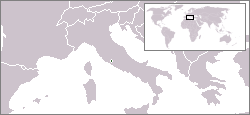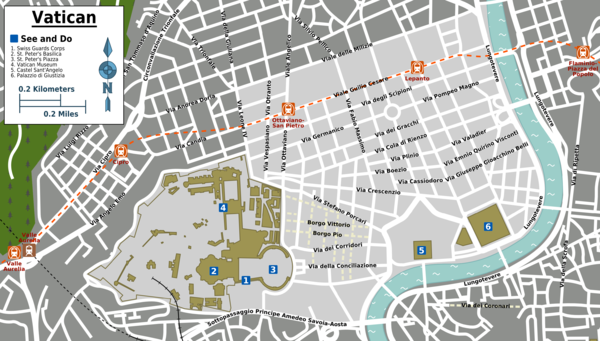 | |
| Location | |
 | |
| Ensign | |
 | |
| Basic information | |
| Capital | Vatican City |
| Goverment | Theocracy/elective monarchy |
| Currency | euro (EUR) |
| Area | 0.44 sq km |
| Population | 821 (estimated July 2007) |
| Language | Latin (official), Italian (official) |
| Religion | Roman Catholic (100% and official) |
| Power system | 230V/50Hz (European or Italian socket) |
| Phone number | 39 |
| Internet TLD | .va |
| time zone | UTC 1 |
Vatican City (pronounced: Vatican or Vatican), official name Vatican City State; Latin: Status Civitatis Vaticanae; Italian: Stato della Città del Vaticano), is a sovereign state whose territory includes a walled enclave, located in the heart of the city of Rome, Italy. With an area of approximately 44 hectares (108.7 acres), it is the smallest independent country in the world.
overview
It was founded in 1929 by the Lateran Treaty as a successor to the larger Papal State, which existed from AD 756 to 1870. Because it is run by the Bishop of Rome (or the pope), Vatican City is officially a monarchy. The highest-ranking officials of the state are all teachers of the Roman Catholic Church.
It is also the sovereign territory of the Holy See (Latin: Sancta Sedes) and home to the Apostolic Palace - the residence of the Pope - and the Roman Curia. Therefore, although the headquarters of the Catholic Church in principle, the Basilica of Saint John Lateran - known as the mother church of all churches - is located in Rome, outside the borders of the country, the Vatican is still allowed. is the ecclesiastical center of the Roman Catholic Church.
History
Just before the arrival of Christianity, it was thought that this was the uninhabited, wasteland of Rome. That land was well protected by the gods, or at least unsuitable for living. The area was also the former place of worship for the Phrygian goddess Cybele and her husband Attis during the time of the Ancient Roman Empire. Agrippina the Great (14 BC - October 18, 33 AD) drained the hill and surrounding areas to build her garden before the first century AD. Emperor Caligula (August 31, December 24, A.D. 24, dynasty: A.D. 37-41) began construction of an arena in AD 40 and was completed by Nero, the school fight Gaii et Neronis. The Vatican Monument was uniquely created by Caligula from Heliopolis to decorate the arena and is also a remnant to this day. This area became a place of martyrdom for many Christians by the great fire in Rome in AD 64. Ancient legend has it that this is the place where Saint Peter was crucified upside down. Opposite the arena is a cemetery separated by Via Cormelia. Burials, mausoleums and small tombs, as well as altars to pagan gods of other religions, were fortified before the construction of the Constrantinian St Peter's Square in the 4th century AD. The remains of the cemetery increased gradually through different pontificates during the Renaissance, until they were systematically excavated by order of Pope Pius XII from 1939 to 1941.
In 326, the first basilica, Constantinian Square, was built on the tomb of Saint Peter. Since the appearance of the cathedral, there has been a sparse population around the square. The Pope's residence is located near the square, built in the 5th century during the reign of Pope Symmachus (? - June 19, 514, reign: 498 - 514). Popes in a non-religious role came to rule the neighboring regions, establishing the Papal State, which had power over much of the Italian peninsula for more than a thousand years until the mid-19th century, when the The territories of the Pope's State were confiscated by the establishment of the Kingdom of Italy. During that time, the Vatican, but rather the Lateran Palace, in recent centuries the Italian government castle, was not the permanent residence of the Pope, but rather in Avignon, France.
In 1970, the papal estate was left in an unclear case when Rome was annexed by the Piedmontese after weak resistance by papal soldiers. Between 1861 and 1929, the prestige of the Pope was mentioned in the book "Questions about the Roman Catholic Church". The Pope is not disturbed at his residence, and is recognized by the guarantee of the law. But they were not recognized by the king of Italy when he enacted the law in Rome, and they refused to allow Vatican lands until their discord was resolved in 1929. Other countries continued to maintain recognition. internationally that the Holy See is a supreme entity. Italy has no intention of interfering with the Holy See in Vatican City. However, they have confiscated Church property in many places, notably including the Italian government castle, the former official residence of the Pope. Pope Pius IX (March 13, 1792 - February 7, 1878, reign: 1846 - 1878), the last head of the State of the Popes, said that after the annexation of Rome, he was "the Man of Vatican prison". The milestone was on 11/2/1929 between the Holy See and the kingdom of Italy. The treaty was signed between Benito Mussolini and Pietro Cardinal Gasparri on behalf of King Victor Emanuel III, and Pope Pius XI (May 31, 1857 - February 10, 1939, reign: 1922 - 1939) on behalf of the Holy See . The Lateran and Covenant (a treaty between the Pope and a government) established the Vatican City State (Vatican State), which, along with the recognition of Catholicism, played an important role in Italy. In 1984, a new covenant between the Holy See and Italy revised several provisions of the previous covenant, including Catholicism's status as Italy's state religion.
Geography
Vatican City State, one of the small European countries, is located on the Vatican hill, northwest of Rome, a few hundred meters west of the Tiber River. The Vatican's border (totaling 3.2 km or 2 miles, all within Italy) is a wall built to protect the Pope from outside forces. The border situation is more complicated at St Peter's Square opposite St Peter's Basilica, where the exact border must cross the square, so there is a virtual border prescribed by Italy running along the outer limit. The square is defined by the Basilica column, bordered by Piazza Pio XII and Via Paolo VI. Vatican City State is the smallest country in the world with an area of about 0.44 square kilometers (108.7 acres).
The Vatican climate is the same as the Rome climate; temperatures, mild Mediterranean weather, snow showers from September to mid-October and hot dry summers from May to August. A feature of the Vatican climate is that it often has fog. much again.
Region

City
Other destinations
- The Apostolic Palace.
- Palace of the Secretary of State.
- St. Martha's Inn. (This is where the Cardinals who attended the Conclave to elect the Pope)
- Vatican Museums.
Arrive
By air
Vaticano doesn't have its own airport, but uses Rome's airport. The Vatican is easy to reach by taxi, bus or on foot from Rome—the nearest neighborhood on the other side of the Tiber is Navona. There is Metro A to Cipro for the Museum, and Ottaviano for St. Peter. A fun ride is to take the tram to Piazza del Risorgimento. From Termini and central Rome, the #64 bus goes directly to the south end of the Vatican, but it is filled with pickpockets to protect your valuables!
Go
Visit
- Peter's Basilica (Latin: Basilica Sancti Petri, Italian: Basilica di San Pietro in Vaticano) is one of the four largest churches in the Vatican. The full name of this building is St. Peter's Apostolic Basilica, but sometimes shortened to St. Peter's Basilica or St. Peter's Basilica). Although not the "mother" church of the Roman Catholic Church, nor the cathedral of the bishop of Rome, St. Peter's Basilica is considered one of the holiest places in Catholicism. teacher. In many cases, its facade and square are symbolic of the Roman Catholic Church and Vatican City. The present church was built on April 18, 1506 and completed on November 18, 1626. Before that, in the 4th century there was also a church built on the present site. The tradition of the Roman Catholic Church believes that the area under the basilica's altar is the tomb of Saint Peter - the bishop of Rome and also the first pope. Peter's Basilica is home to many works of art, most notably those by Michelangelo. Panoramic view of St. Peter's Basilica and Square. This church was started construction on April 18, 1506 on the foundation of another church. It was Pope Julius II who ordered the demolition of this old church to build a new one with the hope that this would be the place to bury himself after his death. Therefore, His Holiness chose the famous painter Michelangelo to lead the construction of this work. However, Michelangelo had to give this position to Donato Bramante due to some controversy over whether the old church should be demolished. Bramante demolished most of the 1,200 year old church foundation along with 4 pillars. After the deaths of Popes Julius II and Bramante in 1513 and 1514, respectively, the work was interrupted several times and led by various architects. Among them was Raffaello, who designed and built the church in the shape of a cross. Some time later, architects Sangallo and Michelangelo respectively continued the construction. For Michelangelo, this is the second time he has led this project. He designed the famous dome, a feat of engineering because it is the brick construction with the largest free bridging distance (24 m long, 120 m high). However, Michelangelo could not complete this dome (he died in 1564) but had to ask the architect Giacomo della Porta. In 1626, after 120 years of construction, the church was inaugurated with 187 m in length and 45 m in height with a capacity of over 60,000 people.
Language
The official language is Latin, along with Italian.
